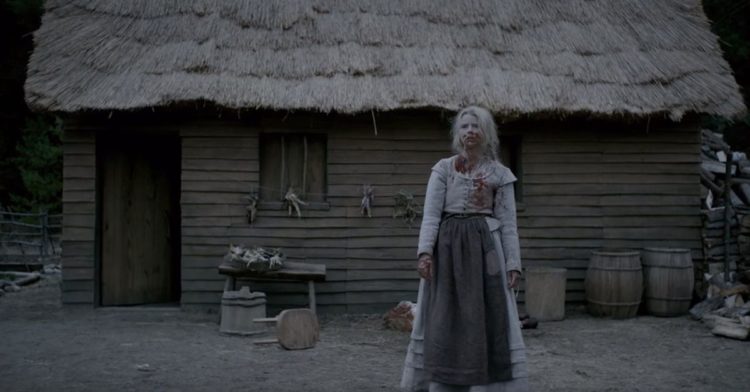
In his review for David Robert Mitchell’s 2014 film It Follows, The Wall Street Journal’s Joe Morgenstern referred to the film as “a vivid example of musically transmitted anxiety.” Thanks to the score by composer and musician Disasterpeace, the film is a ridiculously tense piece of horror. Watching It Follows feels like you’re making clenched fist with your entire body, never quite certain as to what’s next. Vulture’s David Edelstein described it as “the so-upset-I-feel-sick kind of amorphous dread,” and a more perfect summation, I can’t think of to describe what Wikipedia calls the tale of “a teenage girl, Jay, who is pursued by a supernatural entity after a sexual encounter.”

The same can be said of the 2015 directorial debut of Robert Eggers, The Witch. Ann Hornaday, in The Washington Post, points out the “grim, uneasy sense of doom” pervading Eggers’ film. The story of “a Puritan family encountering forces of evil in the woods beyond their New England farm,” as explained by Wikipedia, is an 18-century period piece, which is far different than the setting of Mitchell’s It Follows, which is placed in some strange world which has Priuses, but strangely evokes elements of the ‘70s as well.
Both movies were roundly ripped on social media for not being scary enough — whatever that means — and have gotten hit with the post-horror tag. None of that really matters, except to put in perspective what horror often is. While horror can be different things to different people, it is, at its heart, the sense of fear. Maybe you’re scared by gore, but your partner’s more of a psychological thriller type, but what’s at the root of both is tension. You’re waiting for something to happen, and you don’t know what’s going to happen and, as has been pointed out, both of these movies are tense as hell.

Simon Abrams’ review for RogerEbert.com perfectly frames The Witch and its focus, with the critic describing the film as “about women, and the patriarchal stresses that lead to their disenfranchisement.” Specifically, it’s about “the marginalized presence of women in a male-dominated microcosm, but the harsh conditions that can, even under extremely isolated circumstances, lead women to resentment, and crippling self-doubt.”
Now, that’s a little more focused than It Follows, which is more about Jay’s self-actualized young woman specifically than her place in the world of men. It’s been pointed out that Mitchell’s film can be seen to be a metaphor for sexually transmitted infections. Charlie Lyne, writing for The Guardian, says It Follows has “most of its horror arising from the unforeseen consequences of casual sex, the film undoubtedly invokes the dread associated with sexually transmitted disease.”

Sexuality is definitely a part of The Witch, as well: we see several times wherein Thomasin’s brother, Caleb, is caught, abashed, looking at his sister’s developing figure when her shift gapes open at the top. The ending sees Thomasin’s mother, Katherine, screaming at her that she’s a slut, tempting her brother and her father. Even more than that, the witch of the woods is said by Caleb to have creatures which “feed upon her teats, her nether parts,” and when Black Phillip finally appears, his command to Thomasin is, “Remove thy shift.”
Despite the fact that both It Follows and The Witch feature a young woman who goes through some serious victimizing shit, the strength of each film lies in the fact that both Jay and Thomasin aren’t willing to abide by the way they’re treated. Each movie has a scene which, when viewed on its own, seems undistinguished, but when viewed in the context of the film, becomes deeply unsettling.
For It Follows, it’s the scene when Jay first takes the concept of passing the curse along seriously, and shucks off her clothes to swim out to a boat with several guys partying on it. The idea of a young woman appearing in the midst of a group of partying guys and offering to have sex with them is straight out of an ‘80s sex comedy, but we don’t see anything. We only see Jay wade into the water, and then later, she’s walking into her house.

It’s a powerful scene, because the insane level of risk inherent in the act is obvious. It’s something which could go really, really terribly, and the fact that Jay’s willing to take on that level of danger demonstrates just how far she’s willing to go to rid herself of the curse. Jay’s agency in that scene is emblematic of everything she does in It Follows. She’s willing to accept the help of her friends, but after having something thrust upon her unwillingly in the film’s early scenes, she is the one making the decisions thereafter.
When Thomasin says to her little sister, Mercy, that “‘Twas I what stole him. I be the witch of the wood.” and “I am that very witch. When I sleep, my spirit slips away from my body and dances naked with The Devil. That’s how I signed his book,” it’s originally just an older sister trying to scare her younger sibling, but viewed in the context of how The Witch plays out, her words can be seen to be both foreshadowing and damning, all at once. But, again — it’s a young woman, fed up with her place and the way she’s being treated and perceived, and striking out.

These are two films which really reward repeated viewings, and for those willing to acknowledge the possibility of horror being a slow, agonizing burn, Mitchell and Eggers have created wonderful stories. Pairing the two is a gorgeous, if intense, few hours and will definitely give you things to discuss well into the wee small hours.
It Follows is streaming on Netflix, and The Witch is streaming via Amazon Prime Video. They’re also available on DVD and Blu-ray, although neither really comes with too much in the way of bonus features. They do look super-nice, however.





1 Comment
Comments are closed.